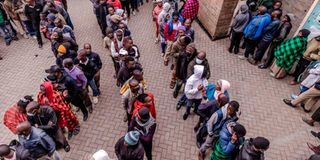Inside an election in Kenya

A group of voters queue while waiting to vote early in the morning at a polling station during Kenya's general election at St. Stephen School in the informal settlement of Mathare in Nairobi, Kenya, on August 9, 2022.
On Tuesday, Deputy President William Ruto was declared the President-elect following the August 9 elections. Runner-up, former Prime Minister Raila Odinga, rejected the results, and the matter is headed to the Supreme Court.
It’s nearly 10 years since President Uhuru Kenyatta and DP Ruto’s winning Jubilee ticket in 2013. Though their platform became rocky and often acrimonious, in the last years, with Uhuru backing Raila against Ruto, now that their journey together is ending, it’s well to look at the country and society they are bequeathing to the next administration.
And the answer to that lies in some things that got lost in the heated campaigns as they pivoted to the character of the candidates—the manifestos of Ruto’s Kenya Kwanza Alliance and Raila Azimio la Umoja One Kenya Coalition Party.
At about this time 10 years ago, then President Mwai Kibaki launched the Konza Technology City. The project was planned to be on 5,000 acres spanning the three counties of Machakos, Makueni and Kajiado. The massive technology hub was estimated to cost $14.5 billion (Sh1.7 trillion).
Gorgeous lawns
Artistic impressions showed a futurist mini-city with gorgeous lawns, new age offices, electric trains and geeky young people in oversized spectacles out to impose Kenya’s technology will upon the world. It was supposed to be Kenya’s new shining on the hill, beckoning the best and brightest and launching on the world table as a medium size technology power.
The dream didn’t die; it was downsized. The Uhuru-Ruto pair created a buzzy catchphrase of their government being “digital” and contrasted themselves with Raila in 2013, who they claimed, represented a dying “analog” world. They came up with tech-filled ideas of giving each school child a laptop. And, despite the International Criminal Court case hanging over their heads for half of their first term, they rode that wave quite well.
In 2017, the technology razzmatazz all but dropped from their manifestos. Both campaigns veered sharply back to the basics and foundational issues in this election. It was well-captured in the symbolism of Ruto’s wheelbarrow and “bottom-up” economic programme. The two manifestos shared a lot in common, offering funds to several constituencies, with Raila putting on the table a proposal to pay Sh6,000 a month in social welfare grants to needy families.
As a soundtrack to the sunset of the campaign, on the back of the global impact of Covid-19 and the Russian war on Ukraine, which has sent energy and food prices sky-high, the Uhuru government unveiled a big unga subsidy. This was no laptop per child, no innovation fund, no Silicon Savannah dreaming but plain maize flour.
The picture of a Kenya with unga subsidies and social welfare cheques would be a contradiction for a first-time visitor zooming to and from Jomo Kenyatta International Airport on the new Nairobi Expressway and past the record number of by-passes and highways built by the Uhuru government with the impressive array of apartments lining them.
Overall, the country has got much better. Before the Covid-19 pandemic, enrolment in primary education had climbed to an impressive 93 per cent, though at the secondary level, it lagged at 53 per cent.
Electricity access has increased sharply in recent years, from 2.3 million connections in 2013 to 8.2 million by the end of 2021, thus achieving an electricity access rate of over 75 per cent, the eighth highest in Africa. It has been ranked as the top country in the world in reducing the population with no access to electricity.
Scary debt
During Uhuru’s time, Kenya rose from Africa’s 12th wealthiest country to sixth, although it is swimming in a sea of scary debt for the effort. Interestingly, the stalled Konza, inspired by Silicon Valley in San Francisco, perhaps best tells the story of the condition of many parts and sections of society in Kenya today.
Silicon Valley is one of the richest places on Planet Earth and home to a record number of its billionaires. But San Francisco also has the third-highest per capita homelessness rate of all major American cities and third highest percentage of unsheltered homeless. The flyovers, in many places, allow us not to have to make eye contact with the deprived on the ground. Up there, we see the ones who made it, not those who fell through the cracks.
Ruto and Raila’s manifestos were meant as a road map for the next five years. But they were even better as portraits of Kenya today. Both leaders—and indeed Uhuru from his departure lounge—understood where Kenya is and what it has become.
It wasn’t a time for visions of cities with driverless electric trains connecting solar-powered glass offices humming with computers and buzzing with nerds inside. It was time for a wheelbarrow and shovel, for handing out a few last gap pennies.
And in the close vote, perhaps a sign that the people are aware of the indignity into which they have fallen and not too happy about it. That shining city on the hill will have to wait.
Mr Onyango-Obbo is a journalist, writer and curator of the “Wall of Great Africans”. @cobbo3





